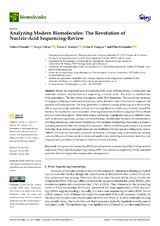Analyzing Modern Biomolecules: The Revolution of Nucleic-Acid Sequencing-Review
Autor
Dorado, G.
Gálvez, Sergio
Rosales, Teresa E.
Vásquez, Víctor F.
Hernández, Pilar
Editor
MDPIFecha
2021Materia
First-generation sequencing (FGS)Second-generation sequencing (SGS)
Third-generation sequencing (TGS)
High-throughput sequencing (HTS)
Next-generation sequencing (NGS)
Structural genomics
Functional genomics
Epigenomics
Metagenomics
METS:
Mostrar el registro METSPREMIS:
Mostrar el registro PREMISMetadatos
Mostrar el registro completo del ítemResumen
Recent developments have revolutionized the study of biomolecules. Among them are molecular markers, amplification and sequencing of nucleic acids. The latter is classified into three generations. The first allows to sequence small DNA fragments. The second one increases throughput, reducing turnaround and pricing, and is therefore more convenient to sequence full genomes and transcriptomes. The third generation is currently pushing technology to its limits, being able to sequence single molecules, without previous amplification, which was previously impossible. Besides, this represents a new revolution, allowing researchers to directly sequence RNA without previous retrotranscription. These technologies are having a significant impact on different areas, such as medicine, agronomy, ecology and biotechnology. Additionally, the study of biomolecules is revealing interesting evolutionary information. That includes deciphering what makes us human, including phenomena like non-coding RNA expansion. All this is redefining the concept of gene and transcript. Basic analyses and applications are now facilitated with new genome editing tools, such as CRISPR. All these developments, in general, and nucleic-acid sequencing, in particular, are opening a new exciting era of biomolecule analyses and applications, including personalized medicine, and diagnosis and prevention of diseases for humans and other animals.
Fuente
Biomolecules 11(8), 1111 (2021)Versión del Editor
http://dx.doi.org/10.3390/biom11081111Ítems relacionados
Mostrando ítems relacionados por Título, autor o materia.
-
A genome-wide analysis of the RNA-guided silencing pathway in coffee reveals insights into its regulatory mechanisms
Fernandes-Brum, Christiane Noronha; Marinho Rezende, Pâmela; Cherubino Ribeiro, Thales Henrique; Ricon de Oliveira, Raphael; Cunha de Sousa Cardoso, Thaís; Rodrigues do Amaral, Laurence; Souza Gomes, Matheus de; Chalfun-Junior, Antonio (Public Library of Science, 2017)microRNAs (miRNAs) are derived from self-complementary hairpin structures, while small-interfering RNAs (siRNAs) are derived from double-stranded RNA (dsRNA) or hairpin precursors. The core mechanism of sRNA production ... -
Characterization of a Mutant Deficient for Ammonium and Nitric Oxide Signalling in the Model System Chlamydomonas reinhardtii
Sanz-Luque, Emanuel; Ocaña Calahorro, Francisco Javier; Galván Cejudo, Aurora; Fernández Reyes, Emilio; Montaigu, Amaury de (Public Library of Science, 2016)The ubiquitous signalling molecule Nitric Oxide (NO) is characterized not only by the variety of organisms in which it has been described, but also by the wealth of biological processes that it regulates. In contrast to ... -
Promoter DNA Hypermethylation and Gene Repression in Undifferentiated Arabidopsis Cells
Berdasco, María; Alcázar, Rubén; García-Ortiz, M.V.; Ballestar, Esteban; Fernández, Agustín F.; Roldán-Arjona, Teresa; Tiburcio, Antonio F.; Altabella, Teresa; Buisine, Nicolas; Quesneville, Hadi; Baudry, Antoine; Lepiniec, Loïc; Alaminos, Miguel; Rodríguez, Roberto; Lloyd, Alan; Colot, Vincent; Bender, Judith; Canal, María Jesús; Esteller, Manel; Fraga, Mario F. (Public Library of Science, 2008)Maintaining and acquiring the pluripotent cell state in plants is critical to tissue regeneration and vegetative multiplication. Histone-based epigenetic mechanisms are important for regulating this undifferentiated state. ...

